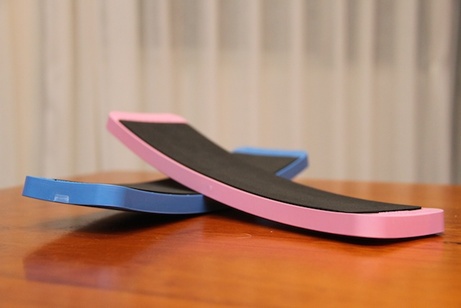 The benefits of turn boards can be debated. There are many aids, products and remedies for dancers on the market which help their training, however the pros and cons of turn boards can be identified easily. Seen in the dance film documentary First Position, it seems turn boards help dancers to master their pirouettes, improve confidence in turning and correct their spotting, balance and posture.
The benefits of turn boards can be debated. There are many aids, products and remedies for dancers on the market which help their training, however the pros and cons of turn boards can be identified easily. Seen in the dance film documentary First Position, it seems turn boards help dancers to master their pirouettes, improve confidence in turning and correct their spotting, balance and posture.
A turn board is a slim rectangular board which works on the principle of reducing friction between the foot and the floor, allowing the dancer to spin fast. While it is clear a turn board delivers a multitude of turns for the dancer, this does not necessarily translate into a number of turns when a turn board is not used. It may however improve dancers’ spotting and allow them to get used to the sensation of performing multiple turns, as well as highlighting small adjustments to be made to improve turns on the floor.
Despite this, a turn board requires the dancer to turn on a flat foot which has potential for problems with technique: in classical ballet, a turn is performed with a releve to either demi or full point. Turn boards may then encourage dancers to turn on a low demi pointe rather than pulling up and turning on a high demi pointe as required. Turning on a flat foot means the foot is not in the same position and the weight distribution is different than for pirouettes in ballet.
Therefore the physicality of a turn, with an adjusted centre of gravity when on flat to demi or full point, is very different with and without the board. For beginners who are just learning turning technique it is likely that the turn board would complicate matters. It could make learning pirouettes harder or encourage bad habits.

 Principal casting for English National Ballet’s autumn UK tour, and performances of the classic The Nutcracker, have recently been announced, with a multitude of pairings to watch once summer is over.
Principal casting for English National Ballet’s autumn UK tour, and performances of the classic The Nutcracker, have recently been announced, with a multitude of pairings to watch once summer is over. In news that may have surprised some musical theatre fans, it has been rumoured that former Pussycat Doll, solo artist and X Factor judge may be in the running to make her West End debut in Cats. It seems Nicole is in “very early discussions” to star in Cats as Grizabella the Glamour Cat, at the London Palladium for the show’s limited run later in the year.
In news that may have surprised some musical theatre fans, it has been rumoured that former Pussycat Doll, solo artist and X Factor judge may be in the running to make her West End debut in Cats. It seems Nicole is in “very early discussions” to star in Cats as Grizabella the Glamour Cat, at the London Palladium for the show’s limited run later in the year.